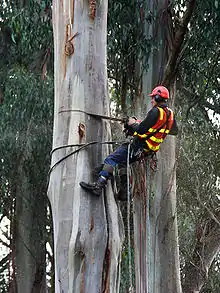Arboriculture
Arboriculture (/ˈɑːrbərɪkʌltʃər/) is the cultivation, management, and study of individual trees, shrubs, vines, and other perennial woody plants. The science of arboriculture studies how these plants grow and respond to cultural practices and to their environment. The practice of arboriculture includes cultural techniques such as selection, planting, training, fertilization, pest and pathogen control, pruning, shaping, and removal.

A person who practices or studies arboriculture can be termed an 'arborist' or an 'arboriculturist'. A 'tree surgeon' is more typically someone who is trained in the physical maintenance and manipulation of trees and therefore more a part of the arboriculture process rather than an arborist. Risk management, legal issues, and aesthetic considerations have come to play prominent roles in the practice of arboriculture. Businesses often need to hire arboriculturists to complete "tree hazard surveys" and generally manage the trees on-site to fulfill occupational safety and health obligations.
Arboriculture is primarily focused on individual woody plants and trees maintained for permanent landscape and amenity purposes, usually in gardens, parks or other populated settings, by arborists, for the enjoyment, protection, and benefit of people.
Arboricultural matters are also considered to be within the practice of urban forestry yet the clear and separate divisions are not distinct or discreet.
UK
Within the United Kingdom trees are considered as a material consideration within the town planning system and may be conserved as amenity landscape[1] features.
The role of the Arborist or Local Government Arboricultural Officer is likely to have a great effect on such matters. Identification of trees of high quality which may have extensive longevity is a key element in the preservation of trees.
Urban and rural trees may benefit from statutory protection under the Town and Country Planning[2] system.
Such protection can result in the conservation and improvement of the urban forest as well as rural settlements.
Historically the profession divides into the operational and professional areas. These maybe further subdivided into the Private and Public sectors.
The profession is broadly considered as having one trade body known as the Arboricultural Association, although the Institute of Chartered Foresters offers a route of Professional recognition and status.
The qualifications associated with the industry range from vocational to Doctorate and as a comparatively young industry, the opportunities are as yet limited and are based in many cases on agricultural wages.
See also
References
- "Amenity landscapes • Environment Guide". www.environmentguide.org.nz. Retrieved 2020-04-28.
- "Town and Country Planning Association". Town and Country Planning Association. Retrieved 2020-04-28.
- Harris, Richard W. (1983). Arboriculture: Care of Trees, Shrubs, and Vines in the Landscape. Englewood Cliffs, New Jersey: Prentice-Hall, Inc. pp. 2–3. ISBN 0-13-043935-5.
- "arboriculture". Merriam-Webster's Collegiate Dictionary, Eleventh Edition. Merriam-Webster.
- "arboriculture". Encyclopædia Britannica Online. 2007.
- "arboriculture". The American Heritage Dictionary of the English Language, Fourth Edition Online. Houghton Mifflin Company. 2000.
External links
| Wikisource has the text of the 1905 New International Encyclopedia article "Arboriculture". |
- Arboriculture Australia Australia
- Arboricultural Association UK
- International Society of Arboriculture (USA)
- European Arboricultural Council
- BatsandTrees.com Promoting the importance of British trees to bats
- Institute of Chartered Foresters The UK based Chartered body for forestry and arboricultural professionals
- American Forests Urban forestry resources
- Encyclopædia Britannica
- . Encyclopedia Americana. 1920.